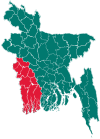Bagerhat Sadar Upazila
Bagerhat
বাগেরহাট | |
|---|---|
 The Sixty Dome Mosque in Bagerhat | |
 | |
| Coordinates: 22°39.8′N 89°47.5′E / 22.6633°N 89.7917°E | |
| Country | |
| Division | Khulna |
| District | Bagerhat |
| Area | |
• Total | 272.73 km2 (105.30 sq mi) |
| Population | |
• Total | 288,673 |
| • Density | 865/km2 (2,240/sq mi) |
| Time zone | UTC+6 (BST) |
| Postal code | 9300[2] |
| Website | Official Map of Bagerhat Sadar |
Bagerhat Sadar (Bengali: বাগেরহাট সদর) is an upazila of Bagerhat District in the Division of Khulna, Bangladesh.[3] The municipality was established in 1958. It consists of 9 wards and 31 mahallas.
History
[edit]Khan Jahan Ali established a pargana named Khalifatabad here in 1429 AD, which covered Bagerhat, Khulna, Jessore, Satkhira and Barisal. The Sixty Dome Mosque was the central administrative place of the kingdom. He built a mint, several mosques, and excavated several lakes.
During the Bangladesh Liberation War, Razakar Seraj Master killed 18 members of a family in the area. Battles between the Pakistan army and the Bangladeshi Freedom Fighters, the Mukti Bahini, were held at Panighat, Devir Bazar and Madhav Kathi.
Geography
[edit]Bagerhat Sadar has 64,022 households and a total area of 272.73 km2. Bagerhat Sadar Upazila is bounded by Fakirhat and Chitalmari upazilas on the north, Morrelganj upazila on the south, Kachua upazila on the east, Rampal and Fakirhat upazila on the west. The main rivers in the area are the Bhairab, Chitra, Daudkhali, Poylahar, and the Putimari.
Demographics
[edit]As of the 2011 Census of Bangladesh, Bagerhat Sadar upazila had 64,022 households and a population of 266,389. 49,111 (18.44%) were under 10 years of age. Bagerhat Sadar had an average literacy rate of 63.58%, compared to the national average of 51.8%, and a sex ratio of 993 females per 1000 males. 49,073 (18.42%) of the population lived in urban areas.[5][6]
As of the 1991 Bangladesh census, Bagerhat Sadar had a population of 235,848. The upazila had an average literacy rate of 49.9% (7+ years), compared to the Bangladeshi national average of 32.4%.[7]
Economy
[edit]Health organization
[edit]In Bagerhat Sadar, there is a 250-bed government hospital, 2 satellite clinics, 10 union health and family planning centers, 1 maternity clinic, 7 private clinics, and 2 nursing training schools.
Main crops
[edit]Paddy, wheat, jute, potato, banana and papaya, garlic, and onion are the main crops of Bagerhat Sadar.
Industry
[edit]In Bagerhat Sadar upazila, there are 28 spice grinding mills, 22 flour mills, 25 rice mills, and 28 coconut oil mills. Cottage industries include 70 goldsmiths, 40 blacksmiths, 60 welders, 1 honey cultivation project, and 1 bidi factory.
Arts and culture
[edit]The Mosque City of Bagerhat, a UNESCO-registered complex of Muslim architecture, is in the suburbs of Bagerhat city. Apart from the mosque recently Khan Jahan Ali's home has been dug out. Concerning modern culture, there are 4 public libraries, 1 museum, 2 cinemas, 25 rural clubs, 1 women's organization, and 1 playground in Bagerhat Sadar Upazila. You can explore the UNESCO property in the Google Arts and Culture Platform Bagerhat on Google Arts and Culture
Administration
[edit]Bagerhat Thana was formed in 1842 and it was turned into an upazila in 1983.[3]
Bagerhat Sadar Upazila is divided into Bagerhat Municipality and ten union parishads:
9. Rakhalgachhi Union Parishad, and
10. Shat Gambuj Union Parishad.
The union parishads are subdivided into 185 mauzas and 187 villages.[5]
Bagerhat Municipality is subdivided into 9 wards and 31 mahallas.[5]
The current UP chairman is Sardar Nasir who was this post for the 1st consecutive time in January 2018.
Notable residents
[edit]- Bidhubhushan Basu, social worker and writer, was born in Kanthal village in 1875.[8][9]
See also
[edit]References
[edit]- ^ National Report (PDF). Population and Housing Census 2022. Vol. 1. Dhaka: Bangladesh Bureau of Statistics. November 2023. p. 399. ISBN 978-9844752016.
- ^ "Bangladesh Postal Code". Dhaka: Bangladesh Postal Department under the Department of Posts and Telecommunications of the Ministry of Posts, Telecommunications and Information Technology of the People's Republic of Bangladesh. 21 October 2024.
- ^ a b HM Khaled Kamal (2012), "Bagerhat Sadar Upazila", in Sirajul Islam and Ahmed A. Jamal (ed.), Banglapedia: National Encyclopedia of Bangladesh (Second ed.), Asiatic Society of Bangladesh
- ^ Population and Housing Census 2022 - District Report: Bagerhat (PDF). District Series. Dhaka: Bangladesh Bureau of Statistics. June 2024. ISBN 978-984-475-278-8.
- ^ a b c "Bangladesh Population and Housing Census 2011 Zila Report – Bagherhat" (PDF). bbs.gov.bd. Bangladesh Bureau of Statistics.
- ^ "Community Tables: Bagherhat district" (PDF). bbs.gov.bd. Bangladesh Bureau of Statistics. 2011.
- ^ "Population Census Wing, BBS". Archived from the original on 2005-03-27. Retrieved November 10, 2006.
- ^ "Long Live Comrade Saroj Dutta". Liberation. Communist Party of India. March 2014. Retrieved August 7, 2014.
- ^ Sarker, Sushanta. "Basu, Bidhubhushan". Banglapedia.

